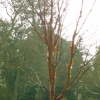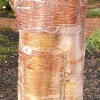Features
This is a relatively small tree (growing to 15m tall) with a bushy habit. It bears dark green, ovate and slightly serrated leaves from spring, which yellow in the autumn.
Its attractively peeling bark is orange-red in colour although the freshly revealed bark is much lighter in colour. The stems have white, horizontal lenticels.
Birches are monoecious, both the male and female flowers occuring in catkins. The resulting seeds are also contained in catkins.
What to use it for
Great as a focal point in a large lawn (ideally with the sun behind it so you can see the peeling bark glowing in the winter), or planted in groups to make the most of the winter display. It’s suitable for most styles or garden, though the bushy habit may be considered a little untidy for very formal designs. Its size would make it perfect for all but the smallest gardens.
Many birch cultivars are grafted and the roostock (often Betula pendula) usually has a fairly shallow root system. This means that some plants may struggle to grow underneath them due to the competition for water and nutrients. However, spring bulbs will usually grow quite happily and colours can be chosen to compliment the winter bark display.
How to look after it
Birches don’t respond well to being transplanted, so if you are purchasing a bare-root tree then ensure it is young enough to adapt to the move. This is less of an issue with pot grown plants which should establish more easily, so long as you water them well after planting.
Little maintenance is required. However, you may choose to wash the bark for a good winter display. This is best done just before winter with a cloth and warm water. A good rub should remove most of the algae which would otherwise dull the colour. Don’t be tempted to peel off any bark yourself, this can damage the tree.
How to prune it
Any pruning should be done when the tree is fully dormant, from late summer until early winter. If you prune in late winter or early spring when the sap is ‘rising’ this can cause heavy bleeding of sap and weaken or even kill the tree.
New trees can be trained as a feathered tree or as a central-leader standard. If you want to have a long, clean trunk (or trunks) to display the bark in winter, you should regularly prune off any side shoots when they are very small, to keep the scars from their removal as discrete as possible.
Other than this, pruning should be kept to a minimum as birches are vulnerable to fungal diseases. As birches are fairly short lived trees, it’s often better to replace a tree than try to prune it to a particular shape or size.
How to propagate it
Softwood cuttings can be taken from mid spring to early summer. Once the cuttings have rooted they should be fed regularly.
Grafting is the most common way of propagating birch cultivars. Generally Betula pendula is used as the rootstock, but Betiula nigra can also be used. Grafting should be done with a whip graft or spliced side graft. Make sure that the compost is kep fairly dry until the scion’s buds break otherwise there’s a risk of too much sap bleeding at the graft point. Pot it on and water as normal once the graft takes.
Common problems
Birches can be short lived trees and older specimens are susceptible to fungal attacks, primarily by birch polypore (Piptoporus betulinus). Diseases including birch rust, powdery mildew, and viruses occur on birches. Pests including the birch leaf mining sawfly, birch aphids, moth caterpillars and leaf weevils can be a problem. Witches’ brooms can also occur, which are sometimes caused by the fungus Taphrina turgida on birches.
Other useful information
The common name ‘birch’ is thought to derive from an ancient word for ‘to shine’, presumably relating to the white bark.
The birch tree has been a great resource for centuries, particularly so because of its quick growth rate. Birch wood is used to make a wide range of products including furniture, charcoal, paper and for fish smoking. Its bark is used as paper and in the tanning industry to fragrance leather. The flexible twigs are traditional used for making brooms and ‘the birch’ – a type of whip which was once used for punishments in schools and prisons.
This cultivar was named ‘Red Panda’ by Jim Gardiner of RHS Garden Wisley in reference to the red panda bears which live in the area of China where the plant originates.









